- Compilation
tells you about the numerous handloom products of the lovely states of Assam
and Manipur.
North-east
India is unique so are its handlooms. Every region is different in terms of
cultural, social and dress characteristics. North-east covers the states of
Assam, Manipur, Nagaland, Tripura, Arunachal Pradesh, Mizoram and Meghalaya.
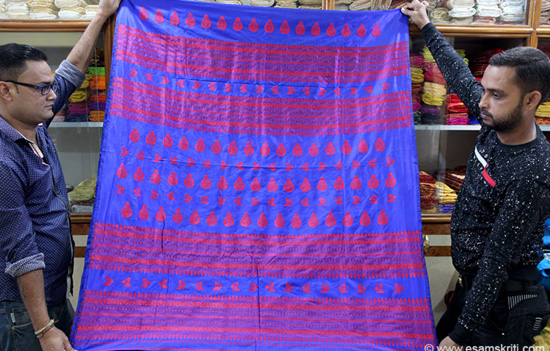 Silk saree at Sualkuchi near Guwahati, known as the
Manchester of the East.
Silk saree at Sualkuchi near Guwahati, known as the
Manchester of the East.
Assam
Textiles
1. Eri Silk
Raw material
Eri
silk is one of the most durable and strong fibres. It is cooling in the
summer and warm in the winter. Eri Cocoons are open mouthed. They are
spun like wool.
Farming
The
eri silk worm is mostly found in tribal areas of Assam.
It
is a very long process which takes around 45 days in total. The growth of the
worm itself takes 30 days during which it is continuously eating the castor
leaves from the trees in the villages.
Once
the final size is attained the worms start to spin their cocoons. This takes
another 15 days. Eri silk, also called Ahimsa silk or peace silk because it does
not require to kill the moth to extract the fiber.
The
wild silk worm called Samia cynthia ricini is covered by its food,
castor leaves in a tribal area of Assam. Before spinning the eri silk cocoons,
the moth has to leave the cocoon and a hole remains.
The
moth leaves the cocoon after spinning and flies off. For this reason, eri silk
is the preferred material by Buddhists.
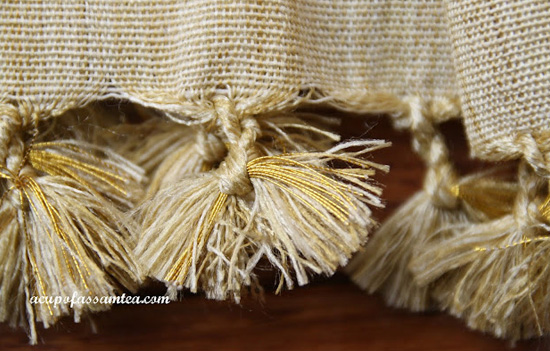
Spinning
In
Assam, there are various techniques of hand-spinning used. Its yarn
has a very
characteristic and ever-changing thickness. Before the silk can be
spun, the moth has to leave the cocoon. The empty cocoons are
washed, boiled and dried before becoming ready for spinning.
Weaving
It is the most common loom in India and in Assam. Almost each household has one for personal use. The fly shuttle loom which is used in Assam and Meghalaya is a bigger loom set up outside or in a workshop with a wooden frame and a plank on which the weaver sits. Often bamboo sticks are used for support or as thinner sticks for warp techniques. The loom is wide and fabric of up to 52” can be woven on it.
Weaving at Sualkuchi, most labourers are Bodos today.
Dyeing
Natural
dyes are used to create different colours. In the village surroundings different
plants exist that have since earlier days been used as dyes.
Leaves
of the teak tree (Tectona grandis) and the henna bush (Lawsonia inermis) are
used. Mehendi, known as henna, grows at many corners of the village and is
utilized for beauty. Its colour is similar to a camel beige.
Teak
leaves are rarely used today. Their shade is an interesting blend of blue,
green and grey tones. Everything is executed in the traditional style:
making a fire, preparing the bath, dyeing the silk and washing the strands at
the pump.
It's fascinating to see and feel one of the eri silk textiles created this way. One can find them in garments, accessories and home textiles etc.
Reference and Credits A
good blog on Eri Silk and also
this one
2. Muga Silk
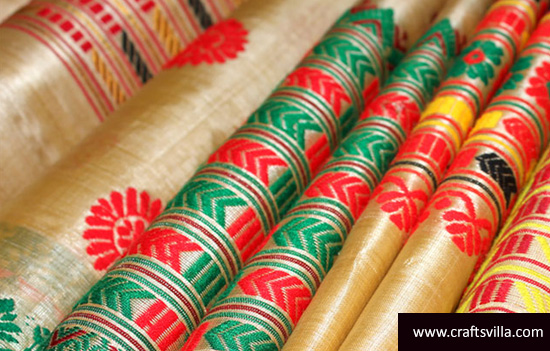
Muga is one of the rarest silks in the world. It is produced only in Assam. What sets apart this silk from others that it is totally golden yellow in color. The word `Muga’ means yellowish in Assamese.
The source of it is the Muga Silkworm
which goes back to the age of the dinosaurs. It is sensitive so cannot tolerate
the most minimum of pollution levels. It is made from the semi-cultivated
silkworm named Antheraea assamensis. It is organic and natural and has the
strongest natural fibre.
It is the most expensive type of silk
so naturally caters to high end users. One of important traits is its
longevity. It is said that generally, a Muga Silk fabric outlives the wearer.
In this fabric the golden luster increases with age.
Muga silk sarees can be given a fine
texture by dry ironing it in a damp state or can have a crushed look by not ironing.
Any type of embroidery by a thread can be done on it. It has got a naturally
golden luster and does not need any dyeing to be done. Yet, it is quite
compatible with most dyes.
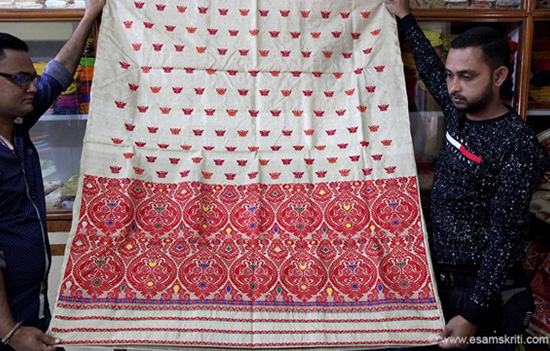 Muga silk saree at Sualkuchi shop.
Muga silk saree at Sualkuchi shop.
Origin and History
It is believed that the cultivation and
weaving of Muga Silk have been going on for a long time. Its golden age was
during 1228 to 1828 i.e. during Ahom rule. The Ahom rulers patronized the
growth of Muga Silk as an industry. They had decreed that all the higher
officials of the kingdom were to adorn only clothes made from Muga Silk. Many looms
were under the royal supervision and known as Rajaghoria looms.
Present day Scenario
Primarily, most of the Muga Silk cultivation takes place in the West Garo hills of Assam and a little bit is done in the west Khasi hills of Assam since they are the only homes to silkworms–Som and Soalu used for muga silk thread.
Typically, in the Garo hill region, a silk
farmer needs to have access to at least one acre of land through which he can
cultivate about 400 grams of Muga silk at a go.
Dresses made out of this Silk sport rich embroidery in the forms of flowers, leaves, trees and Bihu structures giving it a fabulous look. Traditionally this silk was used to make `mehelka–sadar’ (like a saree in Assam) for women and kurtas for men.
It is worth knowing that it takes about
1000 cocoons to generate 125 grams of silk and around 1 kg of silk is used in a
saree. The time taken to make a saree is about two months i.e. from rearing the
silkworm to the finished product. The weaving process for a muga silk saree
takes 7 to 10 days.
Pic
credits
Reference
Everything
you need to know about Assam Silk
3.
Mekhela Chador
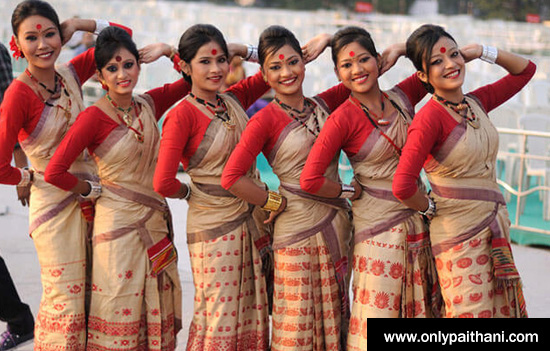
Mekhela Chador (also spelled as Mekhela Chadar, Mekhela Sador or Mekhla Chadar) is a traditional attire worn by the women of Assam. It can be said to be a type of saree comprising two pieces of cloth, draped on the upper and lower parts. The bottom half of this distinct dress is called the ‘Mekhela’ and is used waist downwards over a petticoat. The top portion of the dress is called Chador,
which is let loose at the end like in a saree.
The mekhela is folded into pleats to the right around the waist and tucked in. The chador is tucked into the mekhela’s upper portion at one end and the other end is draped around the upper portion of the body. These days a fitted blouse is worn, unlike earlier times when another piece of fabric known as the riha was worn.
Mekhela Chador in Daily Life
You can use a Mekhela Chador at home
and its fancier versions to a wedding or special functions.
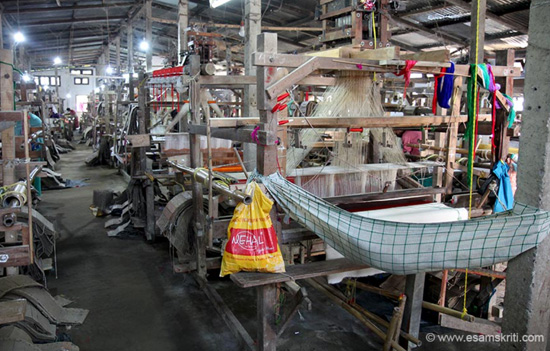 Loom at Sualkuchi that makes only Mekhela Chador.
Loom at Sualkuchi that makes only Mekhela Chador.
Production of Material
It is the women weavers of Assam (mainly
Bodos today) who make the Mekhela Chadors. The primary hub of these Mekhela
Chadors is a small town called Sualkuchi, at 35 kms from Guwahati.
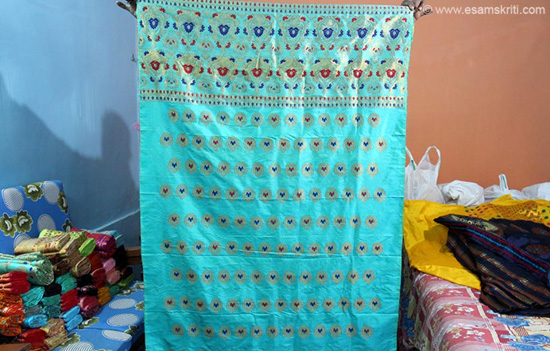 Mekhela Chador sold at Sualkuchi shop.
Mekhela Chador sold at Sualkuchi shop.
Various Types of Mekhela Chador
The Mekhela Chadors are usually found
in three varieties and are differentiated on the basis of the silk used. The
different varieties are -
Muga Mekhela Chador: These are made
of Muga Silk and are believed to be so durable that they often outlive their
owners.
Eri Mekhela Chador: These are made
with Eri Silk and are usually soft and warm in nature.
Pat Mekhela Chador: These are made
with Pat Silk and are generally white in colour.
How to Maintain and Style Mekhela Chador
The Mekhela Chadors are typically very
low maintenance dresses, particularly the ones made from Muga Silk. They can be
hand cleaned quickly.
The Mekhela Chador can quickly be
accented with lockets including huge, colorful pearls, earrings of medium size
and large silver bangles. These improve the charm of the user and add grace to
their character.
Pic
credits , Reference and Good
blog
4.
Matka Silk
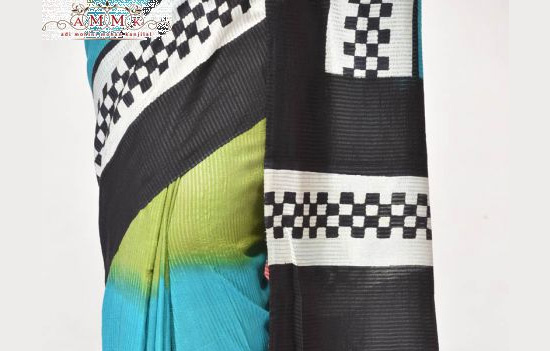
Matka silk sarees are rough handloom silk fabrics made from very thick yarns spun out of pierced cocoon in the weft and organize in warp. Cocoons required to produce Matka silk are mainly obtained from Karnataka and Kashmir but spinning is mostly done in the villages of Malda and Murshidabad districts of West Bengal. Mainly spun by hand, the filaments of the cocoons of this silk were originally unwound and plied together on a mud pot, called Matka in the local language and that’s how it got its name.
On
all Matka sarees, there are slabs and irregularities that give the fabric
a unique character. Its texture resembling a tweed cloth, though the fabric
of Matka sarees is thick, light and airy.
Matka Silk Cluster
Matka
silk is a rough handloom silk fabric made from the waste mulberry silk (bombyx
mori) without removing its gum (sericin) part.
Matka silk artisans work from ten
clusters located across the districts of Murshidabad and Burdwan in West
Bengal. Since it is produced from cocoons without killing the pupae
inside or without sacrificing animal life, it is called Non-violent
silk or Ahimsa Silk.
Pic
Credits
, Also see , And here
5. Kamrup Fabrics
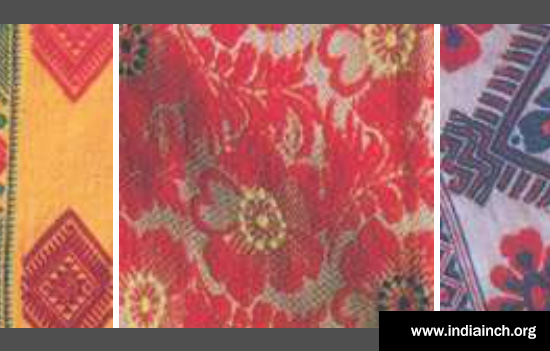
Are there fabrics worthy of a king’s treasure? And are there some qualities that make a fabric to be considered luxurious or of great value? The obvious answer may be “No”. Fabrics are such common items that these are used all over the world for clothes, sheets, blankets, and many other items. So, what can be special about them?
But there indeed are fabrics from the Kamrup region in modern-day Assam which caught the attention of Chanakya when he wrote the book on statecraft- Arthashastra, almost two thousand years ago. Chanakya was responsible for Chandragupta Maurya becoming king. While describing the materials that were worthy for state’s treasure, Chanakya wrote about the qualities of some fabrics. And I quote.
“That which is manufactured in the country, Vanga (vangaka) is a white and soft fabric (dukula); that of Pandya manufacture (Paundraka) is black and as soft as the surface of a gem; and that which is the product of the country, Suvarnakudya, is as red as the sun, as soft as the surface of the gem, woven while the threads are very wet, and of uniform (chaturasra) or mixed texture (vyamisravana).”
Suvarnakudy referred to in the Arthashastra is modern-day Sonkuriha and is a village in Kamrup region of Western Assam. References to Assam as a silk-producing region are found as early as Ramayana where it is called the Kosha-karanam-bhumi ("the country of cocoon rearers"). This silk was so precious that it was used as gifts from one king to another.
King
Bhaskarvarman of Kamrup gifted silk items including a silk umbrella, sacks of
woven silk and silk towels to King Harshavardhana according to historical
records of around the 7th century. Assam silk was traded heavily with China and
Tibet. It is believed that it was from Assam that silk was introduced to rest
of India.
A bit about Silk Production
Silk
is basically a protein fibre i.e. is secreted in a fluid state by larvae of a
silkworm. Its exposure to air makes it harden into a thread. There are several
varieties of silk based on the silkworm and the host plant the worm feeds on.
The method of production can create more varieties and fabrication techniques.
So, a combination of Silkworm, Host Plant, Silk thread production method, and
the fabrication process create quite varieties of fabric. Silk production
techniques originated in China as early as 5000 years ago according to
Confucian texts and from there it spread to Assam. But the production method
for silk makes it controversial what with many Buddhist and Jain monks refusing
to wear silk products. To read more and reference click HERE
To
give silkworms a true surviving chance, Assam silk artisans use a different
silkworm variety called Eri-Silk. Eri silkworm feeds on Castor plants and its
adult moth is capable of flying and surviving after it has hatched.
Pic
credits
, Reference
, Good
read , Gift a loom
6. Nalbari Weaves
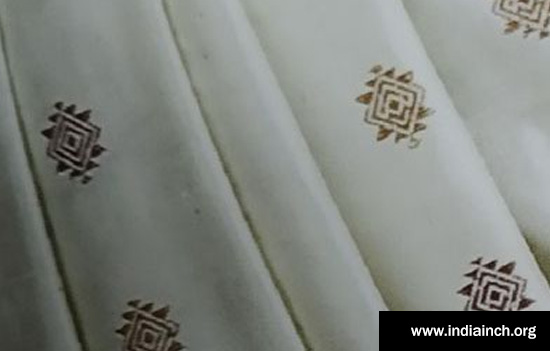
Sahpur Cluster
is in the Nalbari district of Assam. It has 300 plus Artisans &
12 SHGs (self-help groups) supporting them. What is a cluster?
A
cluster is defined as a geographic concentration (a city/town/few adjacent
villages and their adjoining areas) of units producing near similar products
and facing common opportunities and threats. An artisan cluster is defined as
geographically concentrated (mostly in villages/townships) household units producing
handicraft/handloom products. In a typical cluster, such producers often belong
to a traditional community, producing the long-established products for
generations. Indeed, many artisan clusters are centuries old Artisan.
Cane
and bamboo are the two most commonly-used materials in daily life in Assam. To
read all about them click HERE
Pic
credits , Read blog
, Tata
Trusts
Sualkuchi
near Guwahati is known as the Manchester of Assam. To see album sarees
there
Manipuri
Textiles
7 & 8. Manipuri Silk and Cotton
Sarees
Manipuri
designs tend to form interesting patterns through a formal arrangement of lines
which get elaborated to form different shapes and patterns. Manipur is a highly
cultured state with a rich handloom tradition.
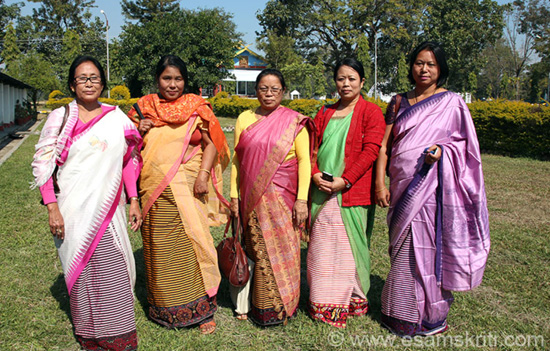 Looks like Manipuri ladies wearing a saree.
Looks like Manipuri ladies wearing a saree.
Full caption-
Actually ladies wearing 3 garments. One is round the waist called Phanek. Above
that what is tied around like a saree is called Inaphi. Since these ladies had
come for a meeting wore a formal top garment called Mayeknaivi.
Cotton
Sari
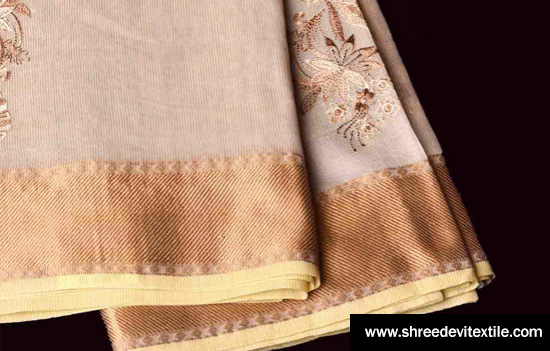
Sari in Manipur is
the quintessential female garment. It is woven with 100% cotton. Cotton sari is
mostly woven on throw shuttle looms. In Manipur, saree designs are a mixture of
hill tribal textiles and floral designs, etc. In most cases, designs are woven
with traditional temple design in border and floral in cross border.
Silk
sari
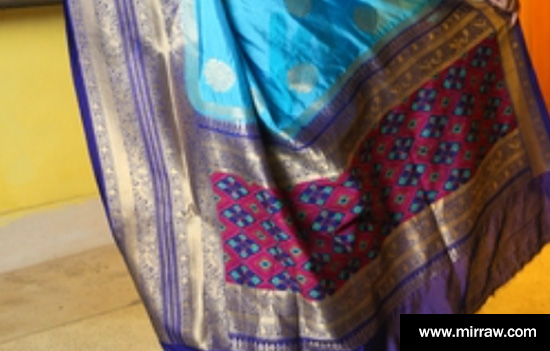
It is woven with
100% silk (Eri) with 20/22 Denier. In most cases, silk saris are woven on both
throw and fly shuttle looms.
Colour
shades like cobra Black, Navy Blue, Maroon, Cherry Red are a style statement of
richness in the state. The embroidery silk sarees are so delicately designed
that you will feel like a Queen when you wear them.
Pic
silk credits
, cotton credits
, cotton saris also see here
9. Changkhom Shawal
Changkhom is one of the most famous shawls
of the Tangkhul Tribe. It is woven with Loin Loom which is the loom used
traditionally. However, there is now a new way of producing on a frame loom. It
is mostly red in colour with a blend of white and black. Every design of a Changkhom
shawl is related to Tangkhul culture.
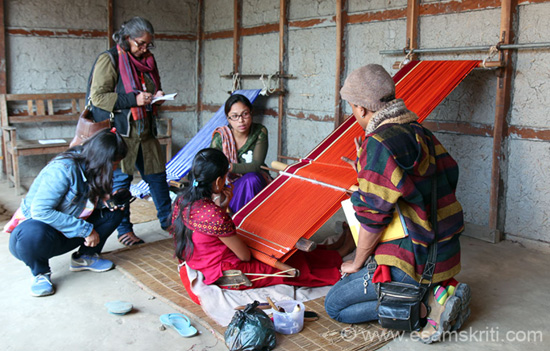 Village outside Imphal. Local lady with the National Institute of Design Alumuni 2014.
Village outside Imphal. Local lady with the National Institute of Design Alumuni 2014.
Traditional hand-looms always been a
part of Manipuri tradition, mostly done by Manipuri women as you can see in
this album.
According to local tradition history surrounding the hand-looms of Manipur is briefly. It is believed that the Goddess Chitnu Tamitnu discovered cotton and created the yarn. The work shed called ‘Sinnaishang’ was made by Her after preparing the weaving threads and arranging all other equipment. It is also believed that Goddess Panthoibee observed the spiders weaving their cobwebs and thus got the idea of weaving with the use of fine threads.
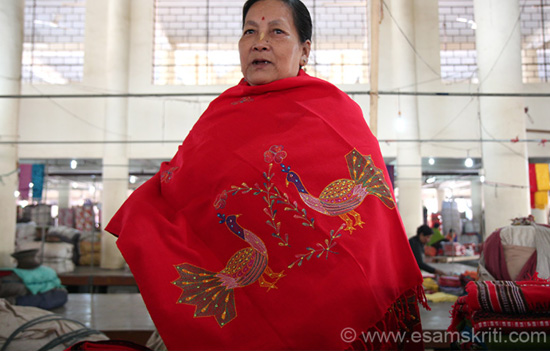 Good place to buy shawls in Imphal is IMA Market.
Note the embroidery.
Good place to buy shawls in Imphal is IMA Market.
Note the embroidery.
There are five hill districts of this
state which specialize in making wonderful designs and motifs. The shawls are
exotic and are famous for the unique fabric of the state. They are in huge
demand in the indigenous as well as overseas markets. A friend from Mumbai who
visited Ima Market, Imphal shopped as if there was no tomorrow.
The typical Imphal shawls come in bright and vibrant colors with interesting
patterns. The designs tend to form a formal arrangement of lines which get
elaborated to form diamonds and geometrical shapes.
Pic credits
, Blog
10. Raivat Kachon
Raivat Kachon is a
different type of shawl of the Tangkhul tribe which is amongst the eleven types
of hand-woven cloths, as mentioned above. An acrylic yarn on the lion loom is
used to weave this. This cloth bears hand-embroidered designs of animals and
insects. This cloth also exhibits ubiquitous characteristics. This cloth
has now been diversified to many other purposes. It is woven with mercerized or
acrylic yarn of 2/32s, 2/34s.
Pic
credits
and reference , Weaves
of North-east India , Go
Coop
11. Mareipan
Mareipan refers to
the shawl that belongs to the Kabui tribe of Manipur. This tribe has fourteen
categories of hand-woven cloth; out of these seven are used by men and seven by
women. Mostly lion loom is used to weave them.
The borders of
these varieties of cloth are aesthetically designed and the colour that is
found to predominate is white. The shades that form the complimentary
combinations for Mareipan are black and red. Acrylic and mercerized yarns are
used for making them.
Imphal City Guide
Shawls
, Good read
12. Pheingao
It is a shawl of
Kabui tribe of Manipur. It is used both by men and women. In most cases, these are
woven on Loin Loom. It is now gradually converting to produce on frame loom
also. These cloths have intricated hand-woven extra weft designs on the border.
In most of Kabui cloth, white colour has a major portion which is complemented
by a little red and black. These cloths have now been diversified to many
other products. These cloths produced both mercerized and acrylic yarn of
2/32s, 2/34s.
Local Manipur clothes
link
13. Haopheisoi (sarong)
It is a
diversified Hand-Woven fabric on fly shuttle loom. It is woven with mercerized
and acrylic yarn of 2/32s, 2/34s developed by Kabui community. Border and longitudinal
warp designs are the traditional motifs with new colour warp and traditional
knotting.
Good
place to buy traditional Manipur handlooms is Ima Market
Imphal
To
see pictures of Textiles and Handlooms displayed at Sangai
Festival 2014
The
purpose of this compilation is to document and promote. We have given credits
and reference links in this compilation along with third party links (to
promote). In case some are missed, it is not with malafide intent. Please
email full details to esamskriti108@gmail.com and we
shall effect the change.
To read all
articles by author
To
read about Handloom Sarees of Odisha
To read all articles on Traditional Textiles of India
Author Trishna
Patnaik
is a self-taught
artist based in Mumbai, Trishna has been practising art for over 14 years. She
is now a full-time professional painter pursuing her passion to create and
explore to the fullest. She conducts painting workshops across India. She is
also an art therapist and healer who works with clients on a one to one basis.
Not to forget her quality writings on Indian Art and now Textiles for
esamskriti. She fancies the art of creative writing.